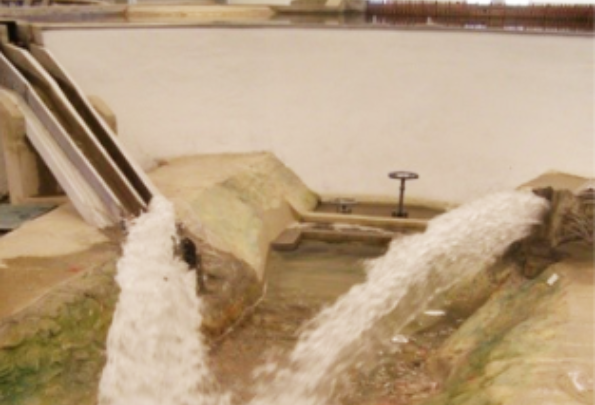Hydraulic and River Structure Models Laboratory


The Hydraulic and River Structure Models Laboratory (UMEHIF) is a LNEC-EM laboratory integrated in the Hydraulics and Environment Department/Water Resources and Hydraulic Structures Unit of LNEC. It develops research and technology based on experimentation and physical modelling. It also provides advanced technical expertise with a view to obtaining sustainable solutions for specific flow problems in rivers, aquifers, and hydraulic structures.
Additional information can be found in this laboratory's flyer.
Activity areas
UMEHIF carries out its activity on experimental channels and small-scale physical models, by developing different types of laboratory tests.
Testing
The objectives of laboratory testing are:
- Characterisation of flows in rivers, aquifers, and hydraulic structures;
- Research and development of technology applied to the physical and experimental modelling of hydraulic structures such as spillways and orifice spillways, stilling basins, intakes, and hydraulic circuits;
- Development of structural solutions for works associated with dams as alternatives to the design ones, promoting the safety and improvement of the hydraulic performance;
- Study of specific aspects of river dynamics (flow in composite and alluvial riverbeds, sedimentation in reservoirs, localised erosions close to bridge piers on alluvial riverbeds, and downstream the dams);
- Design of solutions for protection works against erosion and flooding, as well as for the study of river requalification and rehabilitation solutions (fish passes and other measures);
- Characterisation of the flow resulting from embankment failure;
- Validation and calibration of numerical models
Other services
Highlights
Lisbon Drainage Master Plan (PGDL) – Hydraulic studies on a scale model (scale 1:30) of the entrance of the tunnel Monsanto-Sta. Apolónia and Chelas-Beato. It was performed with the help of digital construction (Cad3D, 3D printing, and CNC machining), considering a modular design. The studies showed that the hydraulic operation of work is appropriate for the range of flood flows predicted in the base design. It was possible to identify some aspects that could be improved in the construction of the work.
Studies about the failure mechanisms due to overtopping of dams and earth dykes, with the help of physical models for characterisation of hydrodynamic and geotechnical phenomena of the evolution of the breach. The studies are aimed at producing a tool for risk management of the failure of dams and earth dykes with a view to increasing the present capacity to reliably predict the formation of breaches and hence contributing to the safety of people and goods.
